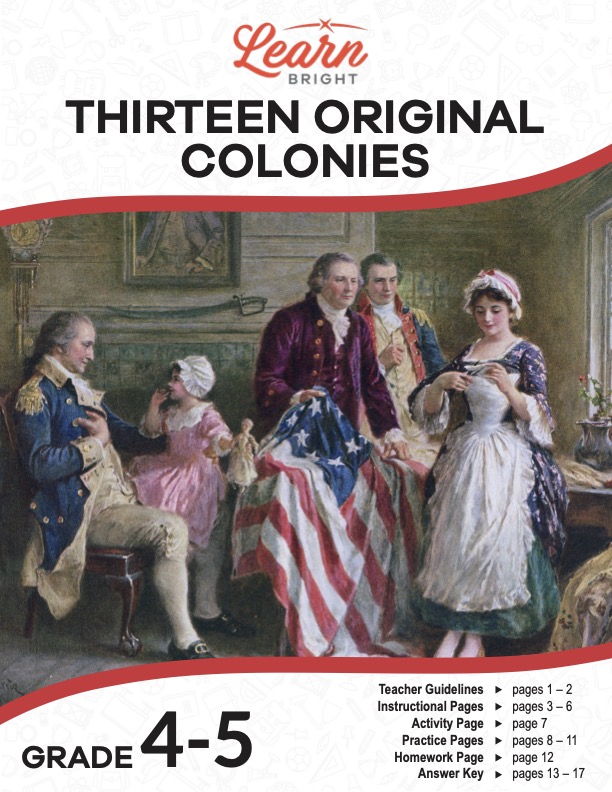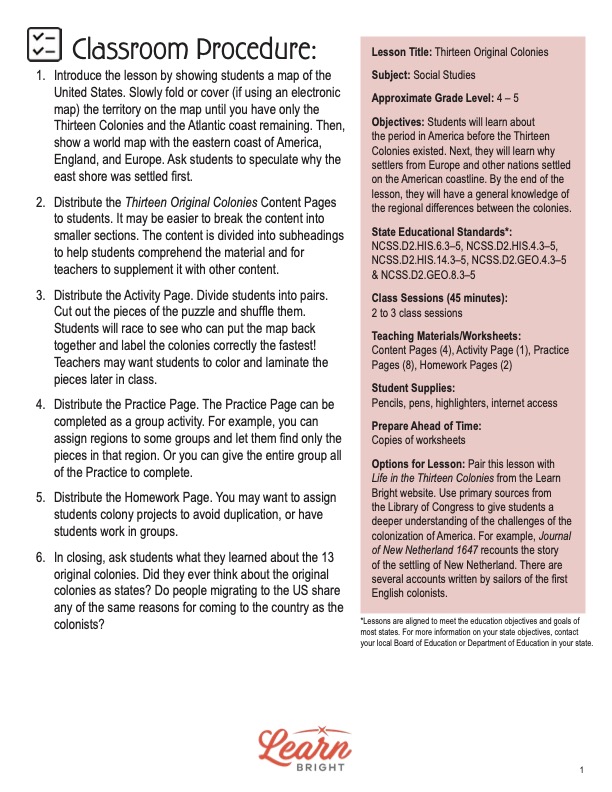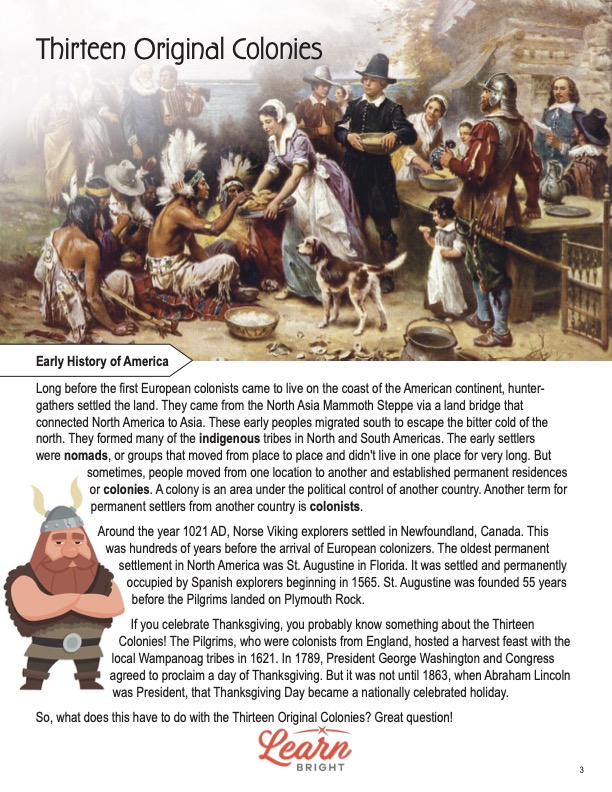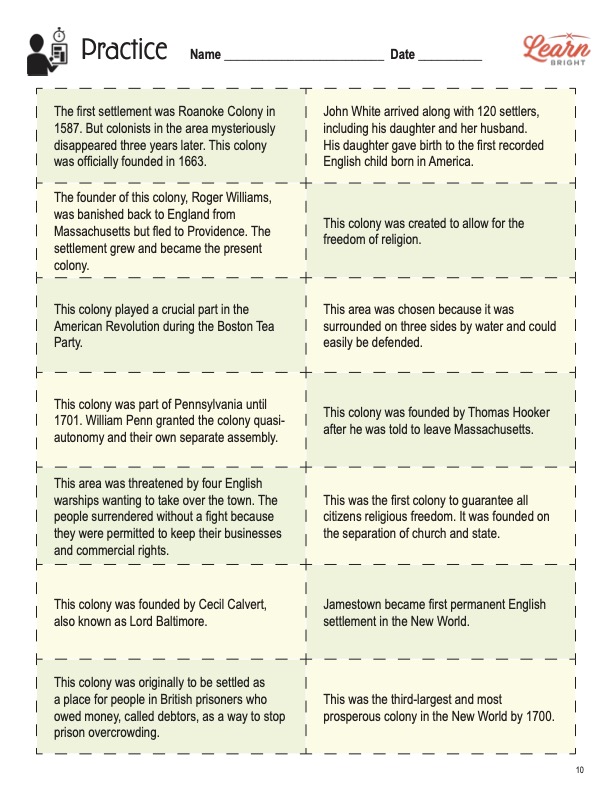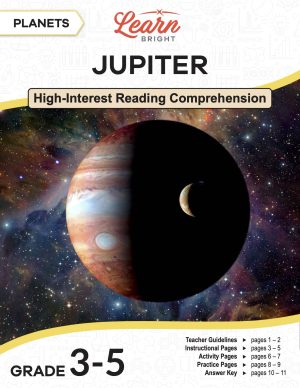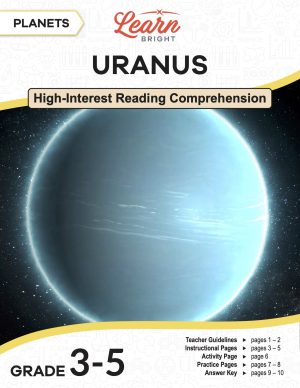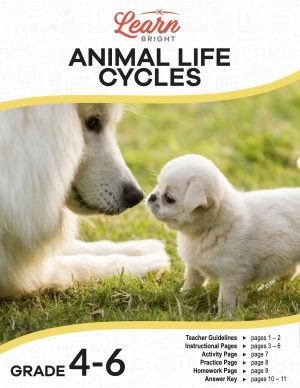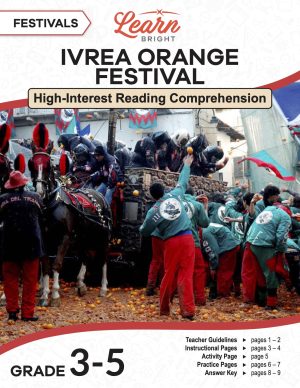Description
What our Thirteen Original Colonies lesson plan includes
Lesson Objectives and Overview: Thirteen Original Colonies teaches students about the period in America before the Thirteen Colonies existed. Next, they will learn why settlers from Europe and other nations settled on the American coastline. By the end of the lesson, they will have a general knowledge of the regional differences between the colonies. This lesson is for students in 4th grade and 5th grade.
Classroom Procedure
Every lesson plan provides you with a classroom procedure page that outlines a step-by-step guide to follow. You do not have to follow the guide exactly. The guide helps you organize the lesson and details when to hand out worksheets. It also lists information in the yellow box that you might find useful. You will find the lesson objectives, state standards, and number of class sessions the lesson should take to complete in this area. In addition, it describes the supplies you will need as well as what and how you need to prepare beforehand. This lesson requires coloring utensils, construction paper or poster board, glue, and access to the internet.
Options for Lesson
You can check out the “Options for Lesson” section of the classroom procedure page for additional suggestions for ideas and activities to incorporate into the lesson. Pair this lesson with Life in the Thirteen Colonies from the Learn Bright website. Use primary sources from the Library of Congress to give students a deeper understanding of the challenges of the colonization of America. For example, Journal of New Netherland 1647 recounts the story of the settling of New Netherland. There are several accounts written by sailors of the first English colonists.
Teacher Notes
The teacher notes page includes a paragraph with additional guidelines and things to think about as you begin to plan your lesson. It mentions that this is a great introduction that complements existing historical content you may be using. This page also includes lines that you can use to add your own notes as you’re preparing for this lesson.
THIRTEEN ORIGINAL COLONIES LESSON PLAN CONTENT PAGES
Early History of America
The Thirteen Original Colonies lesson plan includes four pages of content. Long before the first European colonists came to live on the coast of the American continent, hunter-gathers settled the land. They came from the North Asia Mammoth Steppe via a land bridge that connected North America to Asia. These early peoples migrated south to escape the bitter cold of the north. They formed many of the indigenous tribes in North and South Americas.
The early settlers were nomads, or groups that moved from place to place and didn’t live in one place for very long. But sometimes, people moved from one location to another and established permanent residences or colonies. A colony is an area under the political control of another country. Another term for permanent settlers from another country is colonists.
Around the year 1021 AD, Norse Viking explorers settled in Newfoundland, Canada. This was hundreds of years before the arrival of European colonizers. The oldest permanent settlement in North America was St. Augustine in Florida. It was settled and permanently occupied by Spanish explorers beginning in 1565. St. Augustine was founded 55 years before the Pilgrims landed on Plymouth Rock.
If you celebrate Thanksgiving, you probably know something about the Thirteen Colonies! The Pilgrims, who were colonists from England, hosted a harvest feast with the local Wampanoag tribes in 1621. In 1789, President George Washington and Congress agreed to proclaim a day of Thanksgiving. But it was not until 1863, when Abraham Lincoln was President, that Thanksgiving Day became a nationally celebrated holiday. So, what does this have to do with the Thirteen Original Colonies? Great question!
What Does “Thirteen Colonies” Mean?
It is important to know that in American history, the Thirteen Original Colonies do not refer to the first colonies in America. Instead, they are the 13 colonies that became the first states of the future United States. For example, modern-day Florida, which was settled by the Spanish at St. Augustine, is not included as one of the original colonies. So, what are the Thirteen Original Colonies?
The lesson plan provides a map at the top of the page. The map shows the Thirteen Original Colonies with respect to present-day states. The colonies are all on the Atlantic coast. What you can’t see from the map is that France and Spain claimed a lot of America in the early days!
Chronological Order of the Founding of the Colonies
The lesson also provides a table that shows the Thirteen Original Colonies, the date they were founded chronologically, and the date each colony became a state. It took nine colonies to ratify the Constitution and to become states. New Hampshire became the ninth state to ratify on June 22, 1788. The official date Congress began operating under the United States Constitution was March 9, 1789.
Not all of the colonies were founded by settlers from England. For example, in 1609 Henry Hudson explored the territory around modern-day New Jersey. Hudson was British. However, he worked for the Netherlands and claimed the land for the Dutch. It was called New Netherland.
Eventually, all of the colonies came under British rule. Great Britain was a world power during the 17th and middle-18th centuries. A world power is a nation with a powerful military and a strong economy.
The British navy was the best in the world. It is one reason they could quickly start colonies up and down the eastern coast. The British could establish permanent colonies and govern them even though they were an ocean apart. The military protected the colonists and enforced British laws in America. This was made easier because the majority of colonists were British citizens. The colonies had local governments that interacted with representatives of the British government in the home country.
Although the colonial governments were similar in governance, there were some differences between the colonies. These differences were partly due to the natural resources of each colony and the labor skills that settled them.
Colony Regions
Historians group the colonies into three regions. They are the New England Colonies, Middle Colonies, and Southern Colonies. Keep in mind the map shows the modern political lines of the states. Regions overlap, but you can get some ideas of how the Thirteen Colonies were alike and different. For instance, the New England Colonies had lots of factories while the Middle Colonies were home to mostly fisherman and farmers.
Reasons of the Colonies
The reasons people left their home countries to come to America and start colonies are numerous. Many of the colonists left Europe and Great Britain because they wanted to practice their religion without interference. The governments and churches wanted to have a country with one unified religion. If you believed differently, you would be persecuted and even jailed! Along with religious freedom is personal freedom. Some colonists wanted a life free from government control.
Economic opportunity is the ability to create something new, like a business or product, and own the profits from it. Many thought they could become wealthy in America. A few heard that America was filled with gold and silver! They thought they could find enough gold to become rich and return to their home country. Some colonists had families that had relocated earlier, and they wanted to be with them.
In Europe and Great Britain, jobs were hard to come by, and the wages were low because there was so much competition for labor. Settlers were assured that they would have jobs if they came to America. Owning property was nearly impossible for the average citizen in Europe or Great Britain. Families passed their land down from generation to generation. Most property was owned by a few nobles or families related to the monarchies. In America, property was within reach of those willing to work the land.
Governments persecuted citizens who disagreed with their way of doing things. Many left their home country to protect themselves. You could be imprisoned if you could not repay the money you owed someone. This was called debtors’ prison. In exchange for forgiving their debt and being freed from prison, some settlers came to America to work until they repaid the money they owed others. And there were always those who sought adventure or were explorers! As you can see, there were many reasons for settling in America.
Thirteen Original Colonies and the United States of America
It’s hard for us to imagine the incredible bravery, strength, and resourcefulness of the settlers in the colonies. They left everything they had in Europe and Great Britain. They braved a long, arduous voyage over rough seas, landing in an unfamiliar territory. The colonists fought disease, starvation, and sometimes lack of knowledge to carve from the forests homes, farms, and later cities. Then, the colonists would unite to fight for independence from what was, at that time, the world’s greatest military power.
While each colony had a unique beginning and culture, all the colonies were unified in their experiences. And this unified experience would serve them well when, on July 4, 1776, the colonies declared their independence from Great Britain. Choosing to confront the British in declaring independence from their rule was remarkable but it was only possible because people chose to colonize America.
THIRTEEN ORIGINAL COLONIES LESSON PLAN WORKSHEETS
The Thirteen Original Colonies lesson plan includes three worksheets: an activity worksheet, a practice worksheet, and a homework assignment. Each one will help students solidify their understanding of the material in different ways. You can refer to the guide on the classroom procedure page to determine when to hand out each worksheet.
COLONIES PUZZLE ACTIVITY WORKSHEET
For the activity, students will cut apart the pieces of the 20-piece puzzle at the top of the worksheet page. After shuffling the pieces, they will set a timer and, with a friend, race to assemble the puzzle the fastest. Once they finish the puzzles, students will glue the pieces onto construction paper or poster board and color the map, showing where the colonies are with respect to the rest of the US.
At the bottom of the page, students will describe why they believe the Thirteen Colonies were all on the Atlantic Coast.
THIRTEEN ORIGINAL COLONIES MATCH PRACTICE WORKSHEET
The practice worksheet may be quite the challenge! With a partner, students will first cut out the descriptor pieces, the colony regions and colonies (states). They will place the state cards under the correct region. Then they will cut out all the strips of information and match them to the correct colony. If they cannot find the information they need in the content pages, they can research online or use other sources.
STORY TIME HOMEWORK ASSIGNMENT
Students will practice their writing skills for the homework assignment. They will choose a colony and an interesting fact about that colony. (They can use the strips of information from the practice if they want to.) Then they will write a short essay that describes how that colony came to be.
Worksheet Answer Keys
This lesson plan includes answer keys for the practice worksheet and the homework assignment. Correct answers are in red to make it easier to compare students’ responses to the answer keys. Given the nature of the homework assignment, the answer key is simply a sample response. Students’ answers will vary. If you choose to administer the lesson pages to your students via PDF, you will need to save a new file that omits these pages. Otherwise, you can simply print out the applicable pages and keep these as reference for yourself when grading assignments.

